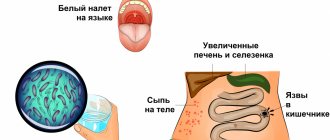Description
Typhoid fever is an acute cyclic intestinal anthroponotic infection.
It develops after the pathogenic bacterium Salmonella typhi enters the body through nutritional transmission routes. This means that the mode of movement of the infectious agent is from the infected organism to the susceptible immune system. It can get inside through already contaminated water, food or dirty hands. That is why it is important to follow basic personal hygiene rules. After infection, a person feels a feverish state, and the body is subjected to general intoxication. The body gradually develops a typhoid status, roseola rashes appear on the upper layers of the epidermis, as well as specific damage to the lymphatic system in the lower parts of the small intestine.
Features of the bacterium Salmonella typhi
The main causative agent of typhoid fever, Salmonella typhi, is an active gram-negative rod that has slightly rounded ends. It stains well if you use aniline dyes to identify it. After entering the body, the bacterium begins to produce endotoxin, which is considered pathogenic only for humans; the process occurs without the formation of spores.
Salmonella is quite resistant to environmental conditions. It can be found in bodies of water where there is fresh water. The bacterium retains its vital activity for one month if it is in liquid. But if it is placed in a milky environment, the bacteria begin to actively multiply and gradually accumulate.
How can you get typhoid fever?
The mechanism of transmission of typhoid fever occurs through ingestion of contaminated food or water. Patients who experience this disease can transmit the bacteria through water supplies after going to the toilet. The patient's stool contains a huge number of pathogenic microorganisms that are well preserved in water.
Some people have a mild type and degree of typhoid fever, so they are not even aware of its existence. It is also difficult to identify in everyday life. As a result, they remain carriers of very dangerous microorganisms for a long time.
Bacteria tend to multiply in the gallbladder, ducts and liver. A carrier of typhoid fever Salmonella typhi may not have any signs or symptoms, so he is unaware of his illness and poses a danger to healthy people. The pathogens retain their viability well in wastewater.
Types of typhoid fever
Increasingly, people are faced with the following types of typhoid fever:
- Typhus. It belongs to a separate group of infectious diseases, which in most cases develop after rickettsia enters the body. The main carriers of the disease from a sick person to a healthy person are body, head or pubic lice, which can spread lice. There are several varieties of this disease - this is epidemic typhus of the rickettsia species R.mooseri and Rickettsia prowazekii. Mice and lice act as pathogens and carriers of infections.
- Relapsing fever. This term is used to designate pathogenic spirochetes of the disease when lice and ticks act as carriers. In this case, the infectious disease of typhoid fever occurs with alternating symptoms. A person may suddenly feel an attack of fever, after which the body temperature returns to its normal value.
- Typhoid fever (dysentery). This is an infectious disease or intestinal anthroponosis, which begins to develop after salmonella bacteria enter the body. There are several clinical forms of this disease - typical and atypical.
There are also several stages of typhoid fever - mild, moderate and severe. For any manifestations of this disease, you must seek qualified medical help. It is also worth constantly observing the rules of personal hygiene, especially in public places.
In the initial phase of typhoid fever, the patient feels a lack of appetite, severe headaches, weakness, malaise, fever, diarrhea and a state of apathy. If no measures are taken in time, a person may experience a relapse of typhoid fever.
Are there complications with typhoid fever?
If you do not consult a doctor in time, the disease may develop into a more severe form, which will complicate the treatment and recovery of the patient. Several centuries ago, even before the introduction of chloramphenicol into medicine, typhoid fever became the cause of the development of severe asthenia, and led to rapid weight loss and malnutrition. In extremely severe forms of the disease, patients experienced internal intestinal bleeding and perforation of the large intestine.
In the first case, erosion of blood vessels occurs in Peyer's patches, as well as places where there is a high accumulation of mononuclear cells in the intestinal walls. Patients note the appearance of blood streaks in the feces. Heavy bleeding occurs three weeks after the onset of the disease. The main clinical sign to pay attention to is a rapid decrease in blood pressure, blood pressure, and body temperature. These are specific complications of typhoid fever that need to be addressed immediately.
Intestinal perforation implies the development of a pathological process in the lymphoid tissue. Gradually, the infection spreads to the muscular and serous layers of the intestinal walls, resulting in its perforation. Antimicrobial drugs help to cope with clinical manifestations in the shortest possible time, as well as prevent complications.
The typhoid fever bacterium in some cases is localized in any internal organs, where it causes the formation of a local purulent process. These processes cause the development of meningitis, chondritis, periostitis, osteomyelitis, arthritis, and pyelonephritis.
The most common complications include pneumonia, which occurs after a bacterial infection enters the body.
Which doctor should I contact if I suspect typhoid fever?
If a person notices the first symptoms of typhoid fever, he should immediately seek advice from an infectious disease specialist. He will listen carefully to all the patient’s complaints and prescribe a full examination to determine the causative agent of the disease. The specialist will definitely pay attention to the medical history and also determine the epidemiological history. This includes identifying contact with infected patients or traveling to infected areas. Often, the doctor may require additional examination, after which he will prescribe the necessary treatment.
To determine typhoid fever, you will need to take cultures and smears for microflora, perform PCR diagnostics, biochemical analysis and blood markers. It is important to remember that the incubation period of typhoid fever is about two weeks, after which the disease begins to develop in an acute form. It is necessary to identify the disease in time for a quick recovery.
Typhoid fever in children
The transmission routes for typhoid fever are varied, and young children often do not wash their hands well after walking, so salmonella infections can easily enter the intestines. Parents will be able to notice the first symptoms very quickly. The child’s behavior and condition change, he becomes lethargic, physical activity decreases, as does his attitude towards his favorite toys.
The acute form of typhoid fever in children is characterized by the appearance of high temperature, fever, pronounced symptoms of intoxication, as well as the detection of roseola rashes on the skin. Children, unlike adults, are more likely to experience negative consequences, so it is important to promptly contact an experienced infectious disease specialist for qualified help.
Children require mandatory hospitalization, where they will receive complex treatment and a special diet. It is important to maintain careful oral hygiene and take care of your skin to protect yourself from developing stomatitis.
Nomenclature
S. enterica
has six subtypes, and each subtype is associated with serovars differing in antigenic specificity.[9]
S. enterica
contains more than 2,500 serovars.[10]
Salmonella bongori
was previously considered a subspecies of
S. enterica
, but is now a different species in the genus
Salmonella
.
Most human pathogenic Salmonella
serovars belong to
the Enterica
subspecies.
These serogroups include S.
Typhoid,
S.
Enteritidis,
S.
Paratyphoid,
S.
Typhimurium and
S.
Cholera.
Serovars may be designated as written in the previous sentence (with a capital letter and no text after the genus), or as follows: “ S. enterica
subsp.
Enterica
, serovar Typhi."
Symptoms
Photo: 2health.ru
Symptoms of typhoid fever depend on the clinical form and severity of the disease. There are typical and atypical (abortive, erased) forms, different types of disease course: recurrent, cyclical. Signs of typhoid fever change as the disease progresses:
- Incubation period. Characterized by general weakness, nausea, and a feeling of weakness. May last from three days to three weeks.
- Temperature increase. The temperature rises gradually and can reach 40 degrees a week after the first symptoms of the disease appear in children.
- Rash on the stomach and chest. The rash of typhoid fever is not bright, round, and has clear contours. Appears after two weeks of illness.
- Intoxication of the body. The patient develops dizziness, weakness, delirium, and sweating.
- Damage to the small intestine and lymph nodes. For typhoid fever, the doctor pays attention to Padalka's syndrome. When tapping the abdominal wall, the specialist may notice that the sound changes in the lower right section. Pain appears in the lower abdomen.
- Damage to the liver, spleen. The liver enlarges, and the person begins to develop jaundice.
If treatment is not carried out, intestinal bleeding may develop with typhoid fever. The disease is dangerous due to its complications: peritonitis, meningitis, cholecystitis and other consequences.
Initial stage of the disease
In adults, symptoms of typhoid fever begin to appear during the incubation period. Patients report malaise, weakness, loss of appetite, headaches and muscle pain. The temperature stays between 37.5-38.5 degrees, rising in the evening.
Peak of the disease
The patient's condition is deteriorating rapidly; with typhoid fever, the temperature can reach 39.5-40 degrees. Patients complain of a number of unpleasant symptoms:
- insomnia, lack of appetite;
- thirst, dry mouth, bitterness on the tongue;
- increased heart rate;
- sweating;
- pain in muscles and joints;
- abdominal pain, bloating;
- lethargy, loss of consciousness.
The timing of the appearance of a rash with typhoid fever ranges from one week to two. The rashes are pinkish, with clear contours, most often in the lower chest, on the sides, and in the upper abdomen. The elements of the rash do not cause any discomfort to the patient. The spots disappear after 3-5 days, new elements may be added, the skin remains slightly pigmented for a short period of time.
During the acute period of the disease, the spleen and liver enlarge. The patient's face becomes pale and puffy. With typhoid fever, unstable stools are noted. Constipation alternates with diarrhea. If a complication develops, bleeding in the intestines and bloody diarrhea appear.
In severe cases of the disease, specialists diagnose patients with “typhoid status,” which is accompanied by the following symptoms:
- loss of consciousness;
- lethargy;
- the patient confuses day and night;
- hallucinations;
- rave;
- trembling in the limbs;
- muscle spasms and cramps.
Reasons for the development of complications: lack of treatment, severe manifestations of the disease.
Fading of symptoms
The acute period of typhoid fever can last about two to three weeks, then a gradual decline in the manifestations of typhoid fever begins. The temperature gradually decreases to normal, stool returns to normal, and symptoms of intoxication disappear. The patient's tongue is cleared of plaque and appetite appears. It is recommended that patients get up only 7-10 days after the temperature has returned to normal.
Complications
If a patient with typhoid fever is not provided with timely medical care, complications may develop with a significant decrease in immunity.
- Intestinal bleeding.
- Perforation of the wall of the small intestine - occurs in case of excessive development of salmonella.
- Meningoencephalitis. The nervous system and brain are affected.
- Peritonitis. The peritoneal mucosa becomes inflamed.
- Kidney failure.
- Typhoid psychosis. Characterized by a disorder of the patient's nervous system.
- Pneumonia. Occurs due to lack of movement of a patient with a high temperature.
- Cholecystitis. Damage to the biliary tract.
- Myocarditis. Disruption of the heart muscle.
- Osteomyelitis. Damage to bone tissue and joints.
- Damage to the urinary tract.
- Death.
After recovery, the causative agent of typhoid fever can live for a long time in the bile ducts and duodenum of a person. Therefore, often a patient who feels absolutely healthy is dangerous to others and can infect healthy family members. Salmonella bacteria can be shed in your stool for more than a year.
Prevention and adherence to hygiene rules will help to eliminate typhoid fever: washing hands after each visit to the toilet, exterminating flies in the premises. If a person’s work involves contact with patients with typhoid fever, it is advisable to get vaccinated.
Recommendations
- Giannella R.A. (1996). Baron S; and others. (ed.). Salmonella.
In:
Baron's Medical Microbiology
(4th ed.). Univ Texas Medical Branch. ISBN 978-0-9631172-1-2. (via NCBI Bookshelf). - Food Poisoning News
- Swanson SJ, Snyder S, Braden SR. et al. (2007). "Multidrug-resistant Salmonella enterica
serotype Typhimurium associated with domestic rodents."
New England Journal of Medicine
.
356
(1):21–28. doi:10.1056/NEJMoa060465. PMID 17202452. - Key, Felix M.; Post, Cosimo; Esquivel-Gomez, Luis R.; Huebler, Ron; Spyrou, Maria A.; Neumann, Gunnar U.; Furtwängler, Anja; Sabin, Suzanne; Burri, Martha; Wissgott, Antje; Lankapalli, Aditya Kumar; Vågene, Åshild J.; Meyer, Matthias; Nagel, Sarah; Tukhbatova, Reseda; Khokhlov, Alexander; Chizhevsky, Andrey; Hansen, Svend; Belinsky, Andrey B.; Kalmykov Alexey; Kantorovich, Anatoly R.; Maslov, Vladimir E.; Stockhammer, Philipp W.; Vai, Stefania; Zavattaro, Monica; Riga, Alessandro; Caramelli, David; Skeets, Robin; Beckett, Jessica; Gradoli, Maria Giuseppina; Steuri, Noah; Hafner, Albert; Ramstein, Marianne; Siebke, Inga; Lesh, Sandra; Erdal, Yilmaz Selim; Alikhan, Nabil-Farid; Zhou, Zhemin; Achtman, Mark; Bos, Kirsten; Reinhold, Sabina; Haack, Wolfgang; Kuhnert, Denise; Herbig, Alexander; Krause, Johannes (March 2021). "The emergence of human-adapted Salmonella enterica is associated with the process of neolithization." Nature Ecology and Evolution
.
4
(3): 324–333. Doi:10.1038/s41559-020-1106-9. ISSN 2397-334X. PMC 7186082. PMID 32094538. - Vågene, Åshild J.; Herbig, Alexander; Campana, Michael J.; Robles Garcia, Nellie M.; Warner, Christina; Sabin, Suzanne; Spyrou, Maria A.; Andrades Valtueña, Aida; Hewson, Daniel; Tuross, Noreen; Bos, Kirsten I.; Krause, Johannes (2018). "Salmonella enterica genomes from victims of a major sixteenth-century epidemic in Mexico". Nature, ecology and evolution
.
2
(3):520–528. doi:10.1038/s41559-017-0446-6. PMID 29335577. - Hensel M (2009). "Secret proteins and virulence in Salmonella enterica". Bacterial secreted proteins: secretory mechanisms and role in pathogenesis
. Caister Academic Press. ISBN 978-1-904455-42-4. - Chinni, Suresh V.; Raabe, Carsten A.; Zakaria, Robaiza; Randau, Gerrit; Hoe, Chee Hock; Seemann, Anya; Brosius, Jurgen; Tan, Tean-Hock; Rozhdestvensky, Timofey S. (09/01/2010). "Experimental identification and characterization of 97 novel candidate ncncRNAs in Salmonella enterica serovar Typhi". Nucleic acid research
.
38
(17):5893–5908. Doi:10.1093/nar/gkq281. ISSN 1362-4962. PMC 2943607. PMID 20460466. - Dadzi, Isaac; Xu, Shungao; Ni, Bin; Zhang, Xiaolei; Zhang, Haifang; Sheng, Xiumei; Xu, Huaxi; Huang, Xinxiang (01/01/2013). "Identification and characterization of a cis-encoded antisense RNA associated with the replication process of Salmonella enterica serovar Typhi." PLOS One
.
8
(4):e61308. Bibcode:2013PLoSO ... 861308D. Doi:10.1371/journal.pone.0061308. ISSN 1932-6203. PMC 3634043. PMID 23637809. - Todar, Kenneth. " Salmonella
and salmonellosis".
Online Textbook of Todara's Bacteriology
. - Murray P.R., Rosenthal K.S., Pfaller M.A. (2009). Medical microbiology
(6th ed.). Philadelphia, PA: Mosby Elsevier. paragraph 307.
Diagnostics
Photo: lebzdrav.ru
The main causative agent of typhoid fever is Salmonella. The bacterium enters the human body through the mouth. The microbe then passes through the large intestine and lymph nodes. It is at this stage that bacteria multiply and enter the circulatory system. In this regard, intoxication syndrome develops.
Diagnosis of typhoid fever: external signs
External indicators are very important when identifying typhoid fever. At the initial stage (duration of the disease is 3-5 days), the patient’s body temperature will reach the highest levels. The face is swollen, the skin is dry, bluish, and roseola-shaped pimples may appear in the chest area.
The patient's tongue is swollen and dry, covered at the base with a blue-gray film, and tooth marks may be found along the edges. The abdomen is swollen, there is rumbling and pain. Testing for typhoid fever in the first 2 days shows a normal white blood cell count. At the last stage of the disease, lymphocytosis, leukopenia, a significant increase in ESR and neutropenia are detected.
Diagnosis using laboratory tests
The most reliable method for detecting the disease is to determine the amount of Salmonella blood culture isolated. Early diagnosis allows one to obtain positive results throughout the entire period of the patient's febrile state.
A typhoid fever test should be performed daily for 3 days. It is recommended to carry out examination on the 1st day before taking antimicrobial drugs. Blood for typhoid fever is taken from the patient in the amount of 5-10 ml per 100 ml of bile-containing medium. For diagnostic purposes, tests are carried out until the patient’s temperature returns to normal. Pus, sputum, exudate fluid, and feces are also subject to examination. They are usually taken for analysis in the 2nd or 3rd week from the onset of the disease. Studies can be repeated if necessary every 5-7 days.
It is worth saying that the bacterial bacillus that caused the disease can be found in the urine and feces not only of a patient with typhoid fever, but also of bacteria carriers during any febrile conditions.
Serological testing for typhoid fever is also of great importance in diagnosis. Research is carried out 7-10 days from the onset of the disease. Serodiagnosis of typhoid fever is aimed at identifying the accumulation of O-antibody titers.
Thus, a positive response with type Vi antigen indicates prolonged carriage of the pathogen. A positive reaction to typhoid fever with the H-antigen indicates that the patient had suffered the disease previously or had been vaccinated. Recently, the disease is increasingly diagnosed using ELISA.
Testing for typhoid fever is carried out by taking stool and bile samples. In this case, diagnosis is aimed at identifying typhoparatyphoid carriage.
Remember: only a doctor should make a diagnosis, since many signs of the abdominal type correspond to symptoms of other diseases. Self-diagnosis (and especially treatment) can lead to irreversible consequences.
Specific prevention of the abdominal type consists of mandatory vaccination enriched with the Vi antigen. Vaccination is carried out for adults and children under 7 years of age. Mandatory and graded vaccination against typhoid fever is carried out for children under 15 years of age and adults.
As for nonspecific prevention, in this case general sanitary measures should be carried out aimed at combating flies (frequent carriers of bacteria), improving the quality of water supply and sanitary cleaning of populated areas, etc.
Epidemiology
Main article: Salmonellosis
Most cases of salmonellosis are caused by food contaminated with S. enterica
, which often affects cattle and poultry, although other animals such as domestic cats[2][
citation needed
] and hamsters[3] have also been shown to be sources of infection in humans. Studies of vacuum cleaner bags have shown that households can act as a reservoir of bacteria; this is more likely if the household has contact with a source of infection (eg family members working with livestock or a veterinary clinic).
Raw chicken and goose eggs may contain S. enterica
, initially in egg whites, although most eggs are not infected.
As the egg ages at room temperature, the yolk membrane begins to break down and S. enterica
can spread into the yolk.
Refrigeration and freezing do not kill all bacteria, but they do significantly slow or stop their growth. Pasteurization and food irradiation are used to kill Salmonella
for industrially produced foods containing raw eggs, such as ice cream. Products made at home from raw eggs, such as mayonnaise, cakes and cookies, can spread salmonella if they are not properly cooked before consumption.
S. enterica
genomes have been reconstructed from 6,500-year-old human remains in western Eurasia, indicating the geographic distribution of systemic
S. enterica
in prehistory and the possible role of the neolithization process in the evolution of host adaptation.[4]
Additional reconstructed genomes from colonial Mexico suggest S. enterica
as the cause of
Cocoliztli
, an epidemic in 16th century New Spain.[5]
Treatment
Photo: cbroadcasting.net
Typhoid fever is diagnosed and treated by infectious disease doctors. All patients undergo therapy in an inpatient setting. Hospitalization is required for the following reasons:
- the disease is infectious;
- there is a risk of infecting others;
- the development of dangerous complications is possible;
- Availability of quality care is the key to a complete successful recovery.
Patients are prescribed a special diet. Etiotropic and symptomatic treatment measures are carried out. Procedures to combat typhoid fever are aimed at neutralizing the infection, increasing the body's immunity and stopping the transmission of the infectious disease. It is also necessary to pay attention to prevention.
Diet
Therapeutic nutrition has a gentle effect on the intestines and does not cause fermentation (putrefactive) processes after consumption. In order for food to be easily digestible, it must be semi-liquid (broths, soups) or rubbed through a sieve. The diet for typhoid fever is high in calories. Frequent consumption of food in small portions is recommended. Drinking plenty of fluids is recommended, preferably warm tea.
Patient care
In addition to the above measures, the patient is recommended to rest in bed for 7-10 days. The prescription must be strictly followed, otherwise straining the abdominal muscles may lead to bleeding or perforation of the intestine. Subsequently, gradual activation is carried out. It is necessary to observe hygienic conditions, both in patient care and in nutrition. Discharge is permitted no earlier than 23 days from the date of admission.
Treatment of typhoid fever in children
Children and adolescents with this disease are also subject to mandatory hospitalization in a hospital. Patients are usually isolated in separate rooms to prevent outbreaks and spread of infection.
During the period of fever, an infectious disease doctor prescribes bed rest and careful care of the skin and oral cavity. A special diet with the necessary nutrients, vitamins, and microelements is prescribed. The specialist uses antibiotics and symptomatic medications in appropriate age-appropriate dosages. In case of severe intoxication, infusion therapy is carried out.
Vaccination
According to epidemiological indications, vaccination of the population is carried out by subcutaneous injection of a liquid anti-typhoid drug into the shoulder. WHO recommends three types of vaccines. Each of them has its own characteristics, a certain adaptation period and dosage.
Vaccination is recommended for those traveling abroad to the countries of Latin America, Africa, and Asia. The optimal time for administering the vaccine is a week before the trip. The average duration of vaccination is 3 years. If you have a history of this procedure, you should consult your doctor about the age of the last vaccination and the relevance of the new one.
Prevention of typhoid fever
As part of prevention, the following activities are carried out:
- It is necessary to strictly follow established sanitary and hygienic rules (from maintaining personal hygiene to organizing water supply).
- You should wash your hands often with warm water and soap.
- According to indications, you should get the appropriate vaccination.
- In areas with poor sanitation, it is recommended to consume only bottled water.
- When the first signs of the disease appear, you should immediately consult a doctor.
Disease prevention also includes supplying the population with high-quality water, timely removal of garbage and sewage from populated areas, insect control, and isolation of infected people.
Medicines
Photo: farmacistiallavoro.it
Treatment of typhoid fever is complex, aimed at fighting infection, eliminating intoxication and dehydration, and preventing complications. Antimicrobial therapy is carried out using antibiotics and sulfonamides. Medicines are prescribed in tablets; in case of frequent vomiting, they are administered parenterally. The duration of the course is usually 7-10 days.
Sorbents are used to remove toxins from the intestines. In severe cases and severe intoxication, intravenous infusions of colloid and crystalloid solutions are indicated. In case of disturbances in the functioning of various organs and systems, appropriate symptomatic remedies are prescribed: sedatives, drugs to improve heart function, vitamin complexes, etc. To normalize the microflora after antibiotic therapy, probiotics and prebiotics are used.
Folk remedies
Typhoid fever is a serious pathology; in the absence of specialized treatment, it can lead to serious complications, including those that pose a threat to the patient’s life. Self-medication is unacceptable; at the first signs of illness you should consult a doctor. Folk remedies are not indicated during the height of the disease. During the recovery phase, a gentle diet with a high content of proteins, vitamins and minerals is recommended. Vitamin teas and decoctions are allowed.
The information is for reference only and is not a guide to action. Do not self-medicate. At the first symptoms of the disease, consult a doctor.





